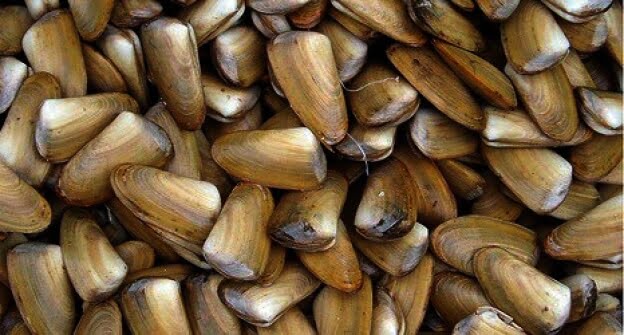For 11,000 years, on the sandy beaches of the Peruvian and Chilean coasts, a unique animal known as “the surf clam,” a representative of the bivalve mollusks (with two shells or valves) and considered an important artisanal fishing resource, has been found.
What does it eat? How does it reproduce? Does it have a brain? How does it breathe?… Here we tell you everything!
What is the surf clam?
It is a marine invertebrate animal (it does not have bones), belonging to the mollusks, specifically to the bivalves or pelecypods, named so because it has a soft body covered by two pieces (external shell) called valves and a muscular foot shaped like an axe.
In turn, the surf clam (Mesodesma donacium) is part of the Order “Veneroids (Veneroida)” in which also are found familiar forms like “clams” so they share similar characteristics, and to the Family Mesodesmatidae.
Other common names are: Green surf clam (larva), Gray surf clam (juvenile), Yellow surf clam (adult).
Characteristics
- Soft body, white or pink in color, covered by two shells or “valves,” triangular in shape, thin, more elongated towards one of the ends (anterior), composed in turn of three layers: external, intermediate, and the inner nacre.
- The valves are joined by the posterior end, at a point called “umbo,” and are connected by tiny teeth (hinge), and a kind of elastic band (ligament).
- Inside, it contains a clear-colored liquid.
- Below the valves is the “mantle,” a thick sheet that forms the body wall; when folded at the edge, it forms a cavity (pallial cavity), which houses the respiratory organs (gills), and the sexual glands (gonads).
- The mantle communicates with the outside thanks to two tubular organs that regulate the water carrying food and oxygen (siphons).
- Inside the valves, a series of marks (pallial impression or line) are observed, produced by the muscles that fix the mantle edge to the shell or valve.
- Additionally, the mantle is responsible for secreting the substance that forms the valves (calcium carbonate), which are normally yellowish-brown in color and have concentric growth lines on the outside.
- It has a flat muscular surface, called “foot,” shaped like an axe, used for moving and digging in the sand.
- Head absent.
- It has a mouth, accompanied by two structures (palps) useful for feeding. It does not have eyes.
- They have stimulus receptor organs distributed in the mantle.
- Variable size (between 6 and 10 centimeters)
- Estimated lifetime, 9 years.

Nervous System
It does not have a brain, but it does have a nervous system consisting of a neural network and a series of pairs of ganglia (small lumps) that control sensory organs (chemoreceptors) and the mantle cavity.
Respiratory System
The surf clam breathes through gills, along with the mantle. The gills are feather-shaped and consist of two bands of filaments (comb-shaped) called ctenidia, which extract oxygen from the water that enters through the siphon (tubular organ) into the body or mantle walls.
Circulatory System
It has an open circulation heart, meaning the hemocyanin (respiratory pigment) flows through the body via a network of small veins.
Digestive System
It has a short esophagus, stomach, and an elongated and straight intestine, which leads to the anus.
Excretory System
To dispose of waste, the surf clam has excretory organs (nephridia) with a function similar to that of vertebrates’ kidneys; they are funnel-shaped and connect to the exterior through an opening (nephropore).
Muscular System
The surf clam has adductor, orbicular, and retractor muscles. The adductors are used to open and close the two valves (shell), the orbicular muscles allow the movement of the body walls and the retraction of siphons (tubular organs that connect with the exterior).
The retractor muscles allow movement of the foot (structure for displacement). Movements occur through a combination of muscular action and water pressure.
Reproductive System
The gonads or organs responsible for the production of sex cells are well differentiated; ovaries in females and testicles in males, which secrete sex cells (ova and sperm, respectively) through an opening or genital pore (called gonopore).
Did you know? The surf clam, like other mollusks, can detect the quality of the water it will filter for feeding, using chemoreceptor organs called “osfradia.”
Habitat
The surf clam is distributed along the coasts of Peru and Chile, buried in the soft substrates of sandy, muddy beaches, in the intertidal zone, meaning areas of strong wave action and occasionally, exposure to air.
They group in “natural banks” or associations, forming a microhabitat (a small ecosystem with favorable conditions for a wide variety of organisms).
Did you know? According to scientific studies, when the sea is at its lowest level, the surf clam closes its shell and forms a layer with a higher concentration of organic matter, showing darker growth lines.
What does the surf clam feed on?
The surf clam is a filter feeder, meaning it filters seawater from the sandy bottom through its gills, which contains various organic particles and plankton (microscopic organisms floating in the water).
It also consumes small crustaceans, polychaetes, and even mollusk larvae.
The palps (organs near the mouth) receive the food and sort it before taking it to the mouth. Wastes are later released through the anal siphon (tubular organs).
How does the surf clam reproduce?
Fertilization is external; the male releases sperm into the seawater and the female lays eggs, which unite and give life to larvae (trochophore larva), which later develop a shell (veliger larva) and swim freely until they find the right place to settle.
From there, they undergo a series of transformations (metamorphosis) until reaching adulthood. The reproductive age varies between 2 and 6 years.
Did you know? In 2017, its consumption in Chile was so high that its extraction was banned in certain areas until 2030.

